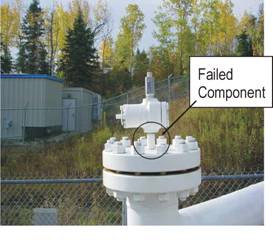ARCHIVED – NEB SA 2004-02 Failures of Threaded Connections
This page has been archived on the Web
Information identified as archived is provided for reference, research or recordkeeping purposes. It is not subject to the Government of Canada Web Standards and has not been altered or updated since it was archived. Please contact us to request a format other than those available.
NEB SA 2004-02 Failures of Threaded Connections [PDF 254 KB]
File 9700-A000-1-30
23 December 2004
To: All Companies under National Energy Board Jurisdiction,
Canadian Energy Pipeline Association,
Canadian Association of Petroleum Producers, and
Provincial Regulators
Subject: National Energy Board Safety Advisory
NEB SA 2004-02
Attached is a safety advisory regarding the hazards associated with the use of threaded connections in applications where they may be subject to external forces and moments. The Board expects that this advisory be given wide circulation to technical personnel involved in design, construction and pipeline operation within your organization.
If you have any questions regarding this Advisory, please contact us toll free at 1-800-899-1265.
Yours truly,
Michel L. Mantha
Secretary
Attachment
Safety Advisory
NEB SA 2004-02
December 2004
Failures of Threaded Connections
Incident Description
On 15 October 2004 a 33.4 mm (NPS 1) x 100 mm (4 inch) threaded both ends nipple failed at the interface between the threads of the nipple and a flange in high pressure sweet natural gas service. The failure was noted as the piping assembly was being pressurized. An undetermined small amount of sweet natural gas was released to the atmosphere. A photograph of the failed piping assembly is provided.

The National Energy Board has received reports of four similar failures in 2004. During the history of the Board, numerous such failures have occurred, some on sour service.
Though these failures have resulted in a low consequence to date, the high frequency of these events merits a warning to industry as the potential for a high consequence failure exists.
Cause of the Incident
The failures typically occur as a result of stresses imposed through normal operation compounded by the stress concentrating effect of the threaded connection. The nipple acted as a lever arm in applying a moment at the connection to the flange. Operation of a plug valve mounted on the nipple and vibration of the piping contributed to the failure.
Preventive Actions
Piping should be designed to avoid unnecessary stress concentrators where practicable. Extreme caution should be taken in the design of threaded connections where movement or externally applied forces can apply excessive stress to threaded joints. Where these stresses are unavoidable, the use of welded connections is preferable. In addition, piping supports should be considered as a means to reduce the moments applied to the joint by external forces.
Existing piping configurations should be assessed and, where necessary, modifications should be made to reduce the possibility of failure.
- Date modified:
